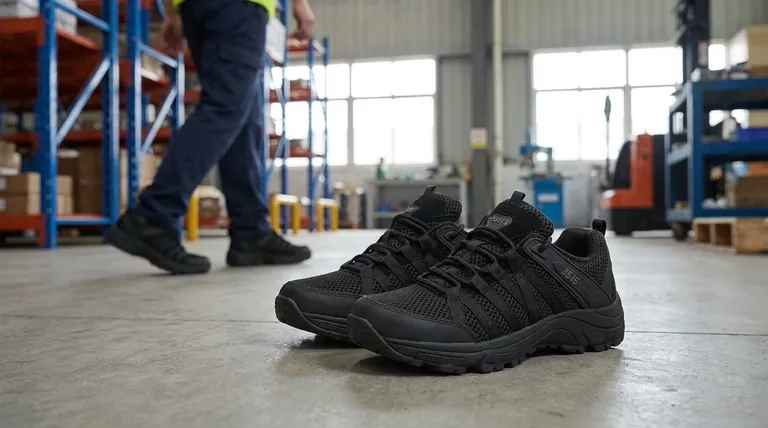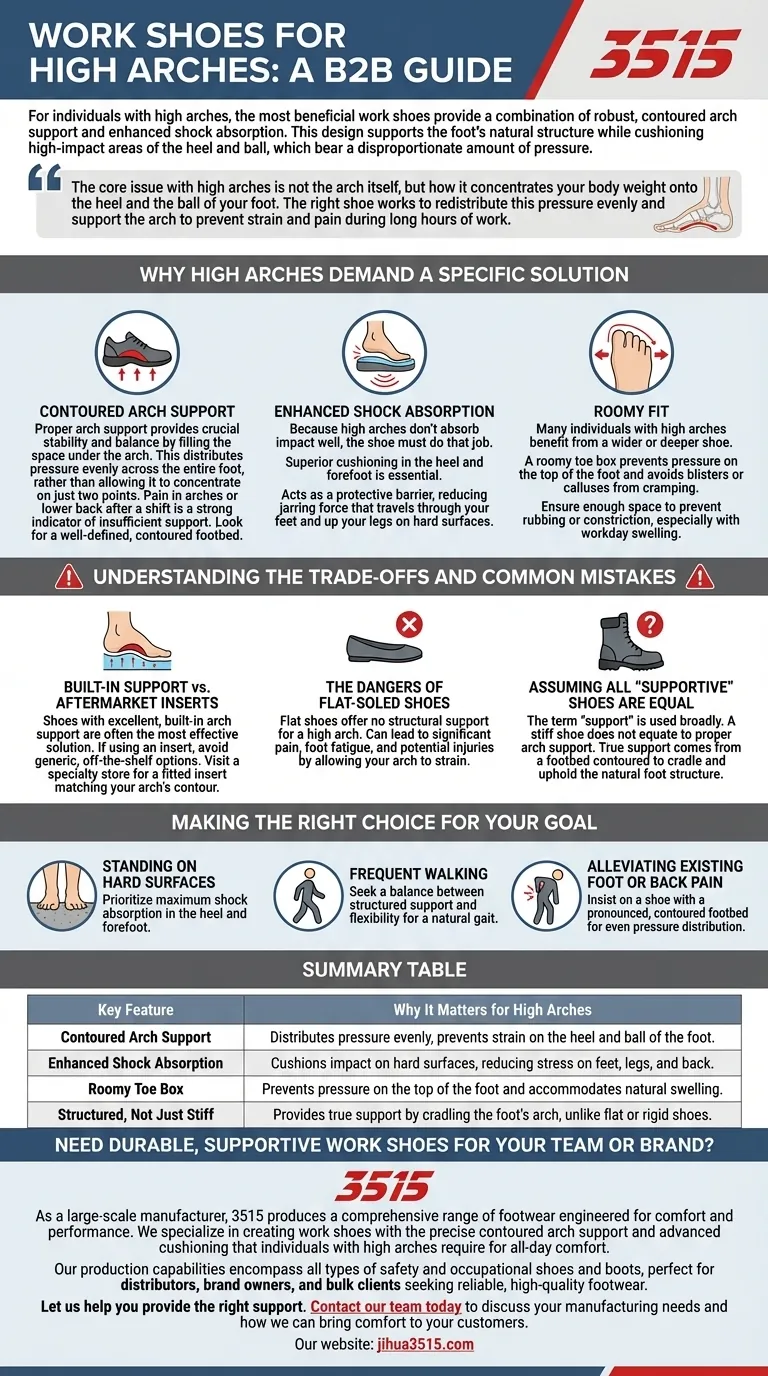For individuals with high arches, the most beneficial work shoes are those that provide a combination of robust, contoured arch support and enhanced shock absorption. This design supports the foot's natural structure while cushioning the high-impact areas of the heel and ball, which bear a disproportionate amount of pressure.
The core issue with high arches is not the arch itself, but how it concentrates your body weight onto the heel and the ball of your foot. The right shoe works to redistribute this pressure evenly and support the arch to prevent strain and pain during long hours of work.

Why High Arches Demand a Specific Solution
A high arch, also known as pes cavus, is less flexible than a neutral arch. This rigidity means the foot is less effective at absorbing the shock of walking or standing, placing excessive stress on other parts of the foot and body.
The Role of Contoured Arch Support
Proper arch support provides crucial stability and balance by filling the space under the arch. This distributes pressure evenly across the entire foot, rather than allowing it to concentrate on just two points.
If you experience pain in your arches or even your lower back after a long shift, it is a strong indicator of insufficient support. Look for shoes with a well-defined, contoured footbed that matches your foot's shape.
The Non-Negotiable Need for Shock Absorption
Because high arches don't absorb impact well, the shoe must do that job. Superior cushioning in the heel and forefoot is essential.
This feature acts as a protective barrier, reducing the jarring force that travels through your feet and up your legs with every step you take on a hard work surface.
The Importance of a Roomy Fit
Many individuals with high arches also benefit from a wider or deeper shoe. A roomy toe box prevents pressure on the top of the foot and avoids blisters or calluses that can form when the foot is cramped.
Ensure the shoe offers enough space to prevent rubbing or constriction, especially after your feet swell slightly throughout the workday.
Understanding the Trade-offs and Common Mistakes
Choosing the right shoe involves more than just picking a single feature. It's about finding the right balance for your specific needs and avoiding common pitfalls.
Built-in Support vs. Aftermarket Inserts
Shoes with excellent, built-in arch support are often the most effective solution, as the entire shoe is designed to work as a single, cohesive system.
If you must use an insert, avoid generic, off-the-shelf options. Visit a specialty store to be fitted for an insert that properly matches the contour of your arch for effective support.
The Dangers of Flat-Soled Shoes
Flat shoes, regardless of current trends, offer no structural support for a high arch. Wearing them for long periods can lead to significant pain, foot fatigue, and potential injuries by allowing your arch to strain under pressure.
Assuming All "Supportive" Shoes are Equal
The term "support" is used broadly. A shoe that is merely stiff does not equate to having proper arch support. True support comes from a footbed that is contoured to cradle and uphold the natural structure of your foot.
Making the Right Choice for Your Goal
Your work environment and daily tasks should guide your final decision. Use these principles to select a shoe that addresses your primary challenge.
- If your primary focus is standing on hard surfaces: Prioritize maximum shock absorption in the heel and forefoot to mitigate the constant impact.
- If your primary focus is frequent walking: Seek a balance between structured support and flexibility to allow for a natural gait while preventing arch strain.
- If your primary focus is alleviating existing foot or back pain: Insist on a shoe with a pronounced, contoured footbed designed to distribute pressure evenly.
Ultimately, investing in footwear that correctly matches your foot's mechanics is the most critical step toward ensuring your comfort and health at work.
Summary Table:
| Key Feature | Why It Matters for High Arches |
|---|---|
| Contoured Arch Support | Distributes pressure evenly, prevents strain on the heel and ball of the foot. |
| Enhanced Shock Absorption | Cushions impact on hard surfaces, reducing stress on feet, legs, and back. |
| Roomy Toe Box | Prevents pressure on the top of the foot and accommodates natural swelling. |
| Structured, Not Just Stiff | Provides true support by cradling the foot's arch, unlike flat or rigid shoes. |
Need Durable, Supportive Work Shoes for Your Team or Brand?
As a large-scale manufacturer, 3515 produces a comprehensive range of footwear engineered for comfort and performance. We specialize in creating work shoes with the precise contoured arch support and advanced cushioning that individuals with high arches require for all-day comfort. Our production capabilities encompass all types of safety and occupational shoes and boots, perfect for distributors, brand owners, and bulk clients seeking reliable, high-quality footwear.
Let us help you provide the right support. Contact our team today to discuss your manufacturing needs and how we can bring comfort to your customers.
Visual Guide

Related Products
- Lightweight Breathable Training Shoes for Wholesale & Custom OEM Manufacturing
- Durable Rubber-Soled Utility Shoes for Wholesale & Custom Brand Manufacturing
- Safety Footwear Wholesale Manufacturer for Custom OEM/ODM Production
- Wholesale Breathable Training Shoes Custom Athletic Footwear Manufacturer
- Premium KPU Injection Athletic Style Safety Shoes
People Also Ask
- How do athletic shoes with non-slip features differ from regular ones? Discover the Grip Advantage
- How do non-slip athletic shoes differ from regular athletic shoes? Discover the Grip Technology
- What is high-tech 'air' mesh, and how is it used in footwear? The Key to Cool, Lightweight Shoes
- What are the benefits of breathable mesh in shoe design? Enhance Comfort and Performance
- What should be considered when choosing smart trainers for business casual? A Guide to Professional Style



















